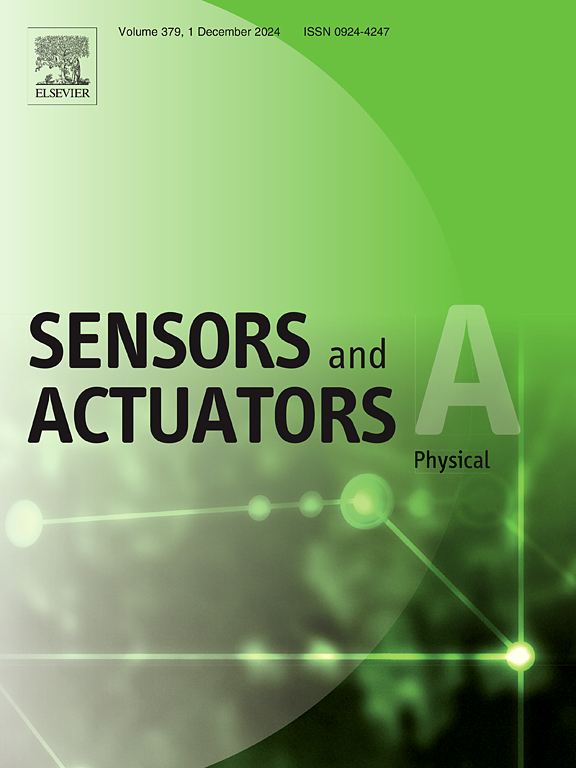实现高灵敏度温度传感器的新型 AlN/ScAlN 复合薄膜 SAW
IF 4.1
3区 工程技术
Q2 ENGINEERING, ELECTRICAL & ELECTRONIC
引用次数: 0
摘要
传统的声表面波器件通常由石英和铌酸锂(LiNbO3)等压电材料制成,面临着与 CMOS 工艺不兼容以及高温下压电性能下降等重大挑战。最近,氮化铝(AlN)和掺钪氮化铝(ScAlN)因其高声速、热稳定性和 CMOS 兼容性而成为高性能声表面波器件的理想材料,备受关注。然而,AlN 的低压电系数和 ScAlN 薄膜中的 Sc 沉淀限制了它们的广泛应用。本研究调查了使用 AlN/ScAlN 复合薄膜制造和优化声表面波谐振器的情况,以提高压电性能,同时减少 Sc 沉淀。基于复合压电薄膜设计了单端口声表面波传感器装置,并通过引入沟槽结构进行了结构优化,以进一步减少声能泄漏并提高品质因数(Q)。利用外围振荡电路系统进行了温度传感实验。实验结果表明,所开发的复合薄膜声表面波谐振器在振荡电路中表现出优异的相位噪声性能和热稳定性,相位噪声为 -135.18 dBc/Hz@1 MHz,频率温度系数为 -31.07 ppm/°C。这些研究结果证实了 AlN/ScAlN 复合薄膜作为可靠而精确的温度传感器的潜力。本文章由计算机程序翻译,如有差异,请以英文原文为准。
Novel AlN/ScAlN composite film SAW for achieving highly sensitive temperature sensors
Traditional SAW devices, typically made from piezoelectric materials like quartz and lithium niobate (LiNbO3), face significant challenges, such as incompatibility with CMOS processes and a decline in piezoelectric performance at high temperatures. Recently, aluminum nitride (AlN) and scandium-doped AlN (ScAlN) have gained attention as promising materials for high-performance SAW devices due to their high acoustic velocity, thermal stability, and CMOS compatibility. However, the low piezoelectric coefficient of AlN and Sc precipitation in ScAlN films limit their broader application. This study investigates the fabrication and optimization of SAW resonators using AlN/ScAlN composite films to enhance piezoelectric performance while mitigating Sc precipitation. A one-port SAW sensor device was designed based on the composite piezoelectric film, and structural optimization was performed by introducing groove structures to further reduce acoustic energy leakage and improve the quality factor (Q). Temperature sensing experiments were conducted using a peripheral oscillator circuit system. The experimental results demonstrated that the developed composite film SAW resonator exhibited excellent phase noise performance and thermal stability within the oscillator circuit, achieving a phase noise of −135.18 dBc/Hz@1 MHz and a frequency temperature coefficient of −31.07 ppm/°C. These findings confirm the potential of the AlN/ScAlN composite film as a reliable and precise temperature sensor.
求助全文
通过发布文献求助,成功后即可免费获取论文全文。
去求助
来源期刊

Sensors and Actuators A-physical
工程技术-工程:电子与电气
CiteScore
8.10
自引率
6.50%
发文量
630
审稿时长
49 days
期刊介绍:
Sensors and Actuators A: Physical brings together multidisciplinary interests in one journal entirely devoted to disseminating information on all aspects of research and development of solid-state devices for transducing physical signals. Sensors and Actuators A: Physical regularly publishes original papers, letters to the Editors and from time to time invited review articles within the following device areas:
• Fundamentals and Physics, such as: classification of effects, physical effects, measurement theory, modelling of sensors, measurement standards, measurement errors, units and constants, time and frequency measurement. Modeling papers should bring new modeling techniques to the field and be supported by experimental results.
• Materials and their Processing, such as: piezoelectric materials, polymers, metal oxides, III-V and II-VI semiconductors, thick and thin films, optical glass fibres, amorphous, polycrystalline and monocrystalline silicon.
• Optoelectronic sensors, such as: photovoltaic diodes, photoconductors, photodiodes, phototransistors, positron-sensitive photodetectors, optoisolators, photodiode arrays, charge-coupled devices, light-emitting diodes, injection lasers and liquid-crystal displays.
• Mechanical sensors, such as: metallic, thin-film and semiconductor strain gauges, diffused silicon pressure sensors, silicon accelerometers, solid-state displacement transducers, piezo junction devices, piezoelectric field-effect transducers (PiFETs), tunnel-diode strain sensors, surface acoustic wave devices, silicon micromechanical switches, solid-state flow meters and electronic flow controllers.
Etc...
 求助内容:
求助内容: 应助结果提醒方式:
应助结果提醒方式:


